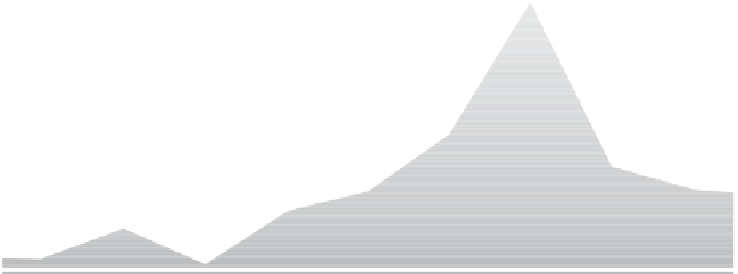Geography Reference
In-Depth Information
Altitude (m a.s.l.)
forest,
glaciers
pasture
mean
altitude
slope
urban
aspect
ma
altitude
x
Figure 6.12. North
-
south transect across Switzerland in terms of basin characteristics visualised by Chernoff faces. From Weingartner (
1999
).
of 428 catchments studied as part of the international Model
Parameter Estimation Experiment (MOPEX) in the USA
fall into just six dominant groups when analysed according
to hybrid climate and runoff regime similarity indices. Most
of the classes turned out to be contiguous. For example, the
LJ class in the north-east (light blue) is characterised by low
seasonality of precipitation and late precipitation peak and
covers a large geographical region.
classification of seasonal flow regimes is ongoing. Clearly
there is a plurality of indices or classifications being con-
sidered or used to characterise similarity of seasonal flow
regime, both process-based and more holistic.
Visualisation of multidimensional indices
It is not easy to visualise many indices at the same time.
A variety of symbolic representations, including trees,
castles and humans, exist that can be used to represent
catchment characteristics (Hartigan,
1975
; Kleiner and Har-
tigan,
1981
;Chernoff,
1973
). For example, each element of
a face can be assigned to a catchment characteristic. The
value of the respective characteristics defines the shape of
the element (e.g., the thickness of hair). These
Catchment similarity indices
The basin characteristics most relevant to regime classifi-
cation include indices describing the surface and subsur-
face structure (e.g., catchment area, average elevation and
slope, drainage density, properties of soils and rocks); land
use (e.g., area of forests, area of glaciers); and hydroclima-
tology (e.g., antecedent conditions). Numerous indices can
be developed that relate to these catchment structural fea-
tures, including elevation, ice (glacial) coverage, drainage
density, forested area and surface permeability (bare rock
coverage) (Breinlinger,
1995
; Laizé and Hannah,
2010
).
The role of structural features on seasonal runoff can be
highly variable: for instance, a given basin property might
influence runoff in one season, but not in others and, when
compared to climate inputs, many properties have limited
influence (Laizé and Hannah,
2010
).
Hybrids of climate and catchment similarity have
accounted for interception capacity, root zone storage,
subsurface flow response and capacity and geomorphology
in addition to aridity (Woods,
2003
). Process-based models
have also been used to derive other similarity indices, for
example the aridity index, a storage capacity index and a
drainability index (Yokoo et al.,
2008
), although evalu-
ation of the effectiveness of these similarity indices for the
'
Chernoff
faces
are a useful qualitative tool for identifying differences
and similarities because most people can recognise the
differences between faces.
Figure 6.12
shows an example
of using Chernoff faces to distinguish catchments along one
north
'
south transect across Switzerland (Weingartner,
1999
). The shape, size, placement and orientation of facial
features
-
represent
particular features of the catchments. Similarity in the
appearance of faces should correlate to their similarity in
parameter space. This example used an existing hydro-
logical classification for Swiss catchments based on basin
characteristics (Breinlinger,
1995
). Faces of ungauged
catchments were allocated to the classification by compar-
ing the facial features of ungauged catchments to the
classified examples. The results suggested that the Chernoff
faces approach was appropriate for a first-order classifica-
tion, largely due to the subjective nature of classifying
catchments based on facial
-
e.g., eyes, ears, mouth and nose
-
recognition (Weingartner,
1999
).







































































































































































































































Search WWH ::

Custom Search